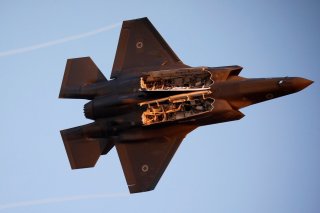S-500: How Russia Plans to Kill F-22 and F-35 Stealth Fighters in a War?
Of all the Kremlin’s latest weapons projects, the S-500 is among Russia’s most direct and potent answers to U.S. fifth-generation stealth fighter jets like Lockheed Martin’s F-35 Lightning II and F-22 Raptor.
Russia’s next-generation S-500 system is coming, and it’s set to take on NATO’s most advanced stealth platforms.
At a Defense Ministry meeting earlier this week, Russian president Vladimir Putin said that Russia’s expansive military modernization programs are proceeding according to schedule. “The latest weapon systems and military hardware are intensively arriving for the Army and the Navy, the potential of the nuclear triad has strengthened substantially and the Navy has expanded its combat capabilities, especially with warships carrying Kalibr cruise missiles.”
Putin noted that as much as 70 percent of the Aerospace Force’s surface-to-air missile regiments have been modernized with the S-400 Triumf missile defense system. He added that the next-generation successor to the Triumf, the S-500 “Triumfator-M,” is well on its way to entering service: “The S-500 system whose trials are successfully nearing completion is next to be delivered to the troops.” It was reported last week that Russia’s military has begun to accept deliveries of the Yenisei radar station, likely an S-500 component.
The forthcoming S-500 not only improves on its S-400 predecessor in most respects but introduces a raft of new capabilities that place it into a performance class of its own. With its upgraded 77N6 series missiles, the S-500 is reportedly capable of intercepting hypersonic cruise missiles and other aerial objects flying at speeds of over Mach 5. The S-500 can engage ballistic missiles at ranges up to 600 kilometers and can target up to ten missile warheads flying at a speed of over four miles per second. The manufacturer, Almaz-Antey, previously claimed that the S-500 can also threaten certain types of low-orbit satellites, though the full extent of its performance at extremely high altitudes remains unclear.
Of all the Kremlin’s latest weapons projects, the S-500 is among Russia’s most direct and potent answers to U.S. fifth-generation stealth fighter jets like Lockheed Martin’s F-35 Lightning II and F-22 Raptor. With its powerful targeting suite and advanced networking capabilities, Almaz-Antey and Russian military observers are projecting confidence that the S-500 can counter low-observable aircraft technology. “The S-500 is a blow against American prestige,” Almaz-Antey head engineer Pavel Sozinov told Russian media. “Our system neutralizes American offensive weapons, and surpasses all of America’s much-hyped anti-air and anti-missile systems.”
Russia’s Deputy Defense Minister Alexei Krivoruchko told reporters that the S-500 will enter service by the end of 2021. "Next year, it is planned to complete trials and introduce into service the S-500 missile system and the Voronezh radar that works in the meter range of wavelengths," he said in a December 2020 interview. It is unknown how many S-500 units are slated for production, and how quickly, though it does not appear that the S-500 will be widely phasing out its S-400 counterpart anytime soon. Rather, the Triumfator-M fills a unique performance niche against the most sophisticated threats facing Russia into the coming decades—in particular, hypersonic weapons and advanced stealth fighters with deep penetration capabilities.
The S-500 is less of a direct replacement to the S-400 than it is an additional layer to Russia’s echeloned air defense network, meant to serve alongside less advanced missile defense systems like the S-400, S-300, and Russia’s vast catalog of short-medium range surface-to-air missile (SAM) systems.
Mark Episkopos is a national security reporter for the National Interest.
Image: Reuters

